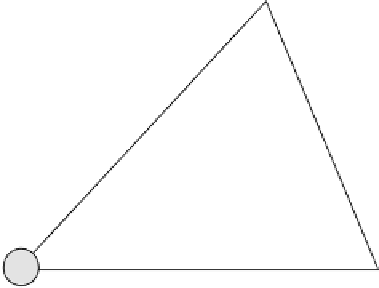Graphics Reference
In-Depth Information
where
A
and
B
are the position vectors for the mass locations
A
and
B
respectively, and
P
is the position vector for the centroid
P
.
If we extend the number of masses to three:
m
A
,m
B
and
m
C
, which are
organized as a triangle, then we can write
m
A
m
A
+
m
B
+
m
C
A
+
m
B
m
A
+
m
B
+
m
C
B
+
m
C
m
A
+
m
B
+
m
C
C
P
=
(11.8)
The three multipliers of
A
,
B
and
C
are the barycentric coordinates of
P
relative to the points
A
,
B
and
C
. Note that the number of coordinates is not
associated with the number of spatial dimensions, but the number of reference
points.
Now consider the scenario shown in Figure 11.5. If
m
A
=
m
B
=
m
C
then
we can determine the location of
A
,B
and
C
as follows:
1. We begin by placing a fulcrum under
A
and mid-way along
BC
as shown
in Figure 11.6.
The triangle will balance because
m
B
=
m
C
and
A
is
1
2
a
from C and
1
2
a
from
B
.
2. Now we place the fulcrum under
B
and mid-way along
CA
as shown in
Figure 11.7.
C
m
C
b
B
′
a
A
′
P
C
′
m
A
m
B
A
B
c
Fig. 11.5.
Three masses organized as a triangle.
m
A
A
c
b
A
′
B
m
B
m
C
C
1
2
a
1
2
a
Fig. 11.6.
Balancing the triangle along
AA
.












